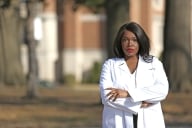You have /5 articles left.
Sign up for a free account or log in.
Since 2007, there have been too many of them to name individually. Day after day and year after year, I have listened to the narrative of their lives and heard the stress in their voices. I have seen the promise of dreams in their eyes and witnessed the cruelty of compromise in their actions. They are bright and they are hardworking. However, economically, they are poor. They are also my students.
I did not plan on becoming a college president. I did not grow up dreaming of a life filled with faculty senates, football and bow ties. I owe my current position as the president of Paul Quinn College less to design than to the confluence of a series of seemingly random events, not the least of which was the fact that I saw potential in a role few others found desirable.
My original career goals were focused on business and public service. However, after a chance encounter during my undergraduate years with Johnetta Cole, an alumna of my college, Oberlin College, and then the president of Spelman College, I began entertaining thoughts of a final career stop as an elder statesman college president. I envisioned becoming the type of higher education leader who would raise large sums of money for a top-tier college or university. Nevertheless, instead of adjusting my postcollege plans to accommodate this new ambition, I stayed true to my original professional intentions and earned graduate degrees in public policy and law.
Life was progressing mostly according to blueprint until 2007, when I became the president of Paul Quinn College. The college is a small, historically black college that for the majority of its 143 years of existence has been known more for the nobility of its struggle and its affiliation with the African Methodist Episcopal Church than for innovation and academic excellence.
At Paul Quinn, we have a diverse student body that is united by the common threads of poverty and service. My days are spent addressing the needs of students who come from families that not only cannot donate money for new buildings, but also most likely qualify for Pell Grants.
In order to help alleviate the financial pressures of their lives, the majority of my students are forced to work significant hours while they are attending college. Their jobs are typically not work-study placements or internships. Rather, these are positions that offer little benefit outside of the steady paycheck that helps to pay their tuition.
The experiences of my students are consistent with what is occurring across today’s higher education landscape. Working while pursuing an undergraduate education has now become a fundamental way of life for many undergraduates. The average college student is not only employed, but working a significant number of hours each week.
According to the National Center for Education Statistics, 40 percent of full-time college students now hold regular jobs. Among those students, three out of five work at least 20 hours per week. Among part-time students, 73 percent hold jobs and four out of five of them log more than 20 hours per week on those jobs. Moreover, a third of part-time students work full-time. When one combines the fact that the majority of public school students now live in poverty with the exploding cost of higher education and the shrinking buying power of America’s middle class, it becomes apparent that barring some dramatic reversal of current conditions, the number of working college students is only going to continue to increase in the coming years.
As my staff and I worked to create policies and programs to help our students manage the reality of their lives, it often occurred to me that I did not really know the lives of my students. That is, I had no real understanding of what it felt like to earn a degree while needing to work significant hours. It seemed to me that my students deserved better than to have an out-of-touch college president. Therefore, in the fall of 2013 and heeding the advice from two of higher education’s most respected voices -- Freeman Hrabowski of the University of Maryland-Baltimore County and Marybeth Gasman of the University of Pennsylvania -- I did what most other college presidents would never consider: I went back to school. For the past two years, I was a member of cohort 13 in the executive doctorate program at the University of Pennsylvania’s Graduate School of Education.
Earning my doctorate while serving as a college president tested my mettle in a way that few other endeavors have. What I experienced during my time at Penn has deeply influenced not just how I lead Paul Quinn, but how I see the world in general. Penn’s program was amazing but intense. In addition to traveling to Philadelphia one extended weekend each month for classes, we wrote more than 60 papers our first year, spent two weeks in Kazakhstan conducting research and wrote lengthy dissertations. The sacrifices required to successfully navigate these requirements helped me see life through a different lens. Among the lessons that I learned or had reinforced were:
1. Compassion goes a long way. Working full-time and attending school full-time was far harder than I imagined. I felt as if I was always behind in some area that mattered. And I was always tired. The days when someone was simply and unexpectedly nice to me made a big, big difference.
2. “Your then was not my then, and your now isn’t even my now.” Our readings and discussions highlighted for me just how much higher education is a caste system. There is an assumption by many people that life would be better for everyone if people only attended or mimicked the practices of “elite” institutions. This is flawed logic. You cannot solve third-world problems using first-world solutions. Such a belief ignores the very real issues that centuries of resource disparities have created in schools and communities. As long as this caste system bias remains, too many students will go underserved.
3. Community counts. Higher education stakeholders have been attempting to solve the wrong problem. Creating pathways for more students to attend college is a laudable goal. However, doing so only addresses part of the issue. Providing a student with an A education without addressing the F conditions of their backgrounds too often produces a C outcome. If we really want to increase retention and graduation rates, we must use our institutions to cure the economic fragility of our students and their communities. When 75 percent of dependent undergraduate students are working an average of 24 hours per week, something is wrong. That is the problem we should be solving.
The truth is that in higher education too many of our leaders are out of touch with the lives of their students. This deficit of personal experience makes it difficult to create policies that alleviate the tension between the institutional need for academic rigor and the students’ desire for an academic experience that acknowledges their daily reality.
While there may be no one right way to solve this problem, we would serve our students much better if more of us were willing to walk a mile in their shoes. What is wrong with authenticity and personal experience becoming more valued in higher education leadership? As my father once told me, “It may be hard to lead people you do not love, but you should never lead people you do not know.”








